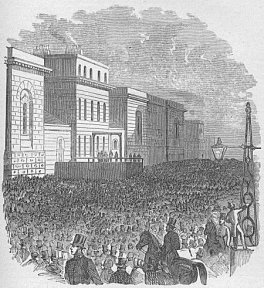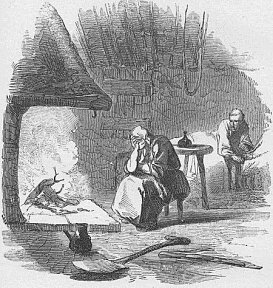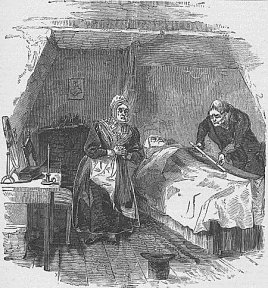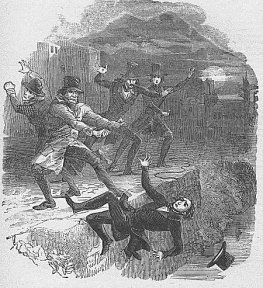
Official Edgar Rice Burroughs Tribute and Weekly Webzine Site
Since 1996 ~ Over 10,000 Web Pages in Archive
Volume 1797b

|
by R.E. Prindle |
The Mysteries Of The Court Of
London
Second Series
by
George W. M. Reynolds

See Part I in Volume
1797
|
Danton Burroughs ERB Archive ~ Tarzana, California www.ERBzine.com/dan Shelf R1 |
Now that I've completed reading all five thousand pages of the Mysteries Of The Court Of London let me say: What a mind blower! What an incredible work of art! What a masterful tour de force! What a powerful and amazing mind George Reynolds had to be able to develop, control and manage his major and minor themes, his hundreds of characters and myriad incidents from beginning to end. The opening and closing incidents united to form a circle like an Ouroboros biting its tail.This was a wonderful novel of Regency England a period of which I am fond anyway. Who could read the sporting novels of R.S. Surtees and not love the place? Thomas Love Peacock? How wonderful, not to mention Byron and Shelley. Not overly concerned with being realistic Reynolds concerns himself with the two social classes of the aristocracy and the criminal element which he portrays as virtually interlinked. One of the more horrifying sequences was the manner in which the hangman, Daniel Coffiin, insinuates himself into the bedroom of the aristocratic but dissolute Lady Ernestina Desalt, nee Cavendish, taking advantage of her when she passes out from fright.
Given five thousand pages and an equally large amount of talent and skill Reynolds is able to develop his characters to an astonishing degree so that they become virtual living entities. Thus while I cannot delineate the moral and physical degeneration of Coffin to the marvelous portrait of him that Reynolds develops nor the character of the reckless Ernestina Dysart, suffice it to say I was almost as revolted at her rape by Coffin as she was when she awoke to be smirkingly so informed by Coffin.
Indeed, this is not a book for prudes. This is one long tale of one seduction, rape or forcible entry after another. Sex permeates the novel from beginning to end. While the story was written in the 1840s psychology appears to have been a topic of much interest as Reynolds and his contemporaries sought the wellsprings of human behavior. Perhaps this interest rubbed off on Burroughs.
Reynolds is as interested in sexual pathology as was Freud if not moreso.
Unlike France where the Libertine period I described in Part I of Something Of Value was interrupted by the Revolution, in England with an unbroken royal tradition from Charles II on Libertinism as an aristocratic prerogative evidently tailed off into the Victorian period as the attitude toward the 'enjoyment' of women as depicted by Reynolds was governed by Regency Libertine bucks.
In one memorable scene an obsessed aristocrat, the Marquis Of Leveson, perhaps patterned after the Marquis de Sade, literally attacks an entrapped 'maiden' sold to him by a procuress. Leveson had a suite of rooms for just such purposes. One room was a gallery of pornographic images to inflame the passions of the women. In the adjoining chamber Leveson had mechanical chairs which when sat on had clasps that secured one's arms and pincers that secured the shoulders.
In this scene that was interrupted by his 'prudish' nephew Leveson is seen tearing the clothes off a 'maiden' he had trapped in a mechanical chair. Her 'glowing orbs' were exposed. That was a scene very reminiscent of the Marquis de Sade who it is possible if not probable Reynolds read during his years in Paris as he ran in some racy circles. Thus these two series are actually mildly pornographic.
The entire second series is named after its heroine Venetia Trelawney. Hers is an interesting story of the sexual proclivities of women. Reynolds is quite balanced in his notions on sex. Venetia was born and raised as Clara Stanley having lived her life cloistered in Canterbury, the cathedral city. For a reason not necessary to give here she finds it necessary to go the metropolis. An innocent on the streets of London her funds are picked from her pocket. A kindly looking woman who, naturally, is a procuress offers her assistance taking Clara to her house of assignation with the intent to sell her to the Marquis of Leveson. Fortunately for Clara he isn't home so Mrs. Gale the procuress takes a different tack. Now, all this information is withheld from the reader and so there are actually mysteries within mysteries. In the first series the royal consort Mrs. Fitzherbert is displaced when Caroline of Brunswick arrives from Germany to be married to Prince George. Mrs. Fitzherbert and another discarded favorite, Miss Bathhurst regret their lass of influence at court developing a scheme to recover it ten years after.
This scheme is to prostitute a young woman as bait for the regent, Prince George. It is their plan that George will fall for the woman, take her into Carlton House, his residence, where she will then through her sexual influence be able to award various favors to the relatives of Miss Bathurst and Mrs. Fitzherbert restoring them to influence as it were. Got some realpolitik here.
Clara, soon to be Venetia Trelawney, is a virgin who doesn't want to appear a wanton so that in order to introduce her into Carlton House she needs a compliant husband who will not object to her being the mistress of the Regent. Not to worry. Miss Bathurst's nephew Horace Sackville, already insinuated as a favorite of the Prince is willing to fill the role.
Reynold's is actually probing fairly deeply into the varieties of sexual experience in a manner that should be familiar to Freudian notions of sex and the conscious and unconscious. In many ways Reynolds is more realistic, sophisticated and penetrating into the mysteries of sex than Freud.
To me the notions of such psychoanalysts as Freud and his epigone Wilhelm Reich are... well... simple minded and superficial, mere projections not based in fact. Their opinion reflects the completely ignorant view of human nature held by the Liberal. Reich in his Sexual Revolution, the Liberal bible on the subject, says: 'If one is not starving one has no impulse to steal and consequently does not need a morality which keeps one from stealing. The same basic law applies to sexuality: if one is sexually satisfied one has no impulse to rape and needs no morality against such an impulse.'
The same applies to prostitution, if a woman is well fed she has no need to sell her charms. All very plausible in theory but running contrary to the facts.
Perhaps the key is the meaning of 'if one is sexually satisfied.' We don't know what is meant by sexual satisfaction. That's a wide open term. Is sexually sated the same as sexual satisfaction? Reich doesn't feel the need to consider that aspect. Indeed, he is probably incapable of doing so. He just makes the blanket assumption, that once one is 'sexually satisfied' rape and prostitution will disappear from the face of the earth. Today we know for a fact this isn't true. Millionaires who are overfed steal and plunder for more millions, or even, billions. I don't have to mention the plundering of the savings and loan industry which was certainly not done by the starving proletariat. The well fed proletariat of the United States also steals. Crime has increased rather than decreased as people are fed better. Nearly everyone steals, fed or not. Prostitutes continue to ply their trade for fabulous sums. Poverty has nothing to do with it.
Even with the primitive psychology of the 1840s Reynolds gives the proverbial two fingers to Freud and Reich.
Reynolds understands that rape and prostitution are means to gratify sexual needs and obtain satisfaction whether sexual or otherwise. Men of wealth and position like Prince George and the Marquis of Leveson had no reason to fear the law they were above it which Reynolds makes quite clear. Depending on what sexual satisfactions means, they were not only sexually satisfied but one would think so sated they would look elsewhere for amusement. According to Reynolds Libertines of this order lived their lives seeking female sexual experiences at any cost.
As already described Leveson considered rape as a tool of the trade. This may seem rather fantastic but when he is unable to gain access to Venetia Trelawney any other way he tricks her by giving her a necklace with a hundred pearls on it that he will redeem at a thousand pounds a pearl. When the last is spent Venetia will have to surrender her charms to him. He then has a criminal associate induce her husband to follow a life of dissipation and gambling. Venetia redeems most of the pearls to pay the gambling debts he incurs. Thus in the end Venetia is reduced to prostitute herself to Leveson for 100,000 pounds.
As a prostitute then Venetia is paid on a colossal scale. Not only have she and her husband been made a peer and peeress with State pensions of thousands of pounds a year also living in splendor and comfort at Prince George's Carlton House, but she is paid millions of dollars at today's exchange for a couple hours of her use by a man who is above the law.
Further as Reynold's makes clear the desires of the male are visited on the female, thus the Prince and his fellows employ pimps and procuresses to deliver women to them for their use. It will be remembered that Mrs. Gale's first intent was to sell Venetia to Leveson.
So, with the human traffic of today, which is to say, women. The women are not volunteering or trying to escape poverty but are seduced into prostitution where then are then kept by force strictly for use of men who can and will pay. Like Leveson and the Prince of Reynold's story it is the men who provide the demand and the women who provide the supply rather willingly or not. These are conscious business decisions on the part of the pimps that have nothing to do with the unconscious. Money is money. Upon close examination Freud's theories begin to break down. A buffoon like Reich is too contemptible to even consider. I pity the Liberals who dig that ass.
As I read Reynolds then I was impressed by his examination of sexual psychology. At only 32 to 34 years of age he seems to have had an especially mature understanding of male and female sexuality.
Burroughs very likely read this novel between his years of 22 to 25, a guess on my part, when the book would have had a formative affect on him. Having read the story the content would have disappeared into his subconscious where the material would have been worked and reworked to form his ideas of sexuality as conditioned by his own morality which is to say his understanding of human relations. The novel may even had a part in the formation of his dreams. We don't know how sexually satisfied ERB was but we do know he wasn't a rapist.
If one analyzes ERB's female figures from the point of view of Reynolds and the Mysteries it is quite possible to see the influence of Venatio Trelawney, as a desirable woman, of the second series in such figures as Dejah Thoris and La of Opar. Even Thuvia may be based on other female characters of Reynolds.
This examination of sexual matters runs all through the Mysteries from beginning to end. Reynolds keeps up shenanigans like those I've described over five thousand pages. It is impossible in a review such as this to give more than a superficial account. There are so many good stories along these sexual lines woven, many times, through hundreds of pages, novels in themselves, that it is quite wonderful. Each is of a different type involving fully delineated distinct characters. The story of the Duchess of Desborough and her husband of the first series is truly amazing stuff. If you've got the time for a five thousand page novel, then, boy, this is it.
As a historical novel the first series is about the profligacies of Prince George and the royal family of George III and that of the Regent George and Princess Caroline in the second series. Both contain the relationship of George to Caroline of Brunswick.
One of Reynolds' conclusions seems to be that unbridled sexual lust is closely related to crime which is something that Freud ignores. In his sexual desires George had secretly married Mrs. Fitzherbert some few years before the arrival of Caroline in 1795. Mrs. Fitzherbert is put out of the way in favor of Caroline in a psychologically brutal way. Ten years later then in 1814 when the second series begins this leads her to the prostitution of Venetia Trelawney in the attempt to regain her ability to take care of friends and relations by putting them on the State dole.
Thus Miss Bathurst and Mrs. Fitzherbert, two of George's former mistresses, one an actual wife still married to him, become procuresses for his pleasures while Miss Bathurst makes a pander of her nephew. Reynolds takes real pleasure in retailing these details that smear the members of the high life.
In the second series the major concern is Geroge's attempt to sexually discredit Caroline as a libertine. He had put her away from him. In the novel she is living a chaste life in Geneva. Thus plans are put into execution to make it appear she is living a sexually abandoned life.
In a real life amusing reply to queries as to her sexual activities she replied that she had only had bigamous relations with one man and that man was her husband. A pointed reference to Mrs. Fitzherbert who had never been divorced from George. As you can see this is good stuff.
One could go on but let me provide only one more example of Reynold's genius. Among the many mysteries are the two central ones introduced in the first few pages and concluded in the last few. God, what skill.
Even here it is impossible to give enough details to give any of the real flavor of the novel. Suffice it to say that George in his pursuit of the Real Thing is discovered by a too curious onlooker when George has set up a rendezvous in a remote country inn. In attempting to escape discovery he seeks refuge in a house. The father is away but the two beauteous daughters are at home. Under the guise of Mr. Harley George seduces the elder daughter Octavia who he impregnates. As this occurs about the time of the arrival of Caroline he is forced to brutally abandon Octavia which in turn drives her insane.
In the course of things her sister Pauline nurses her back to health. Pauline marries a Lord Florimel and an Arthur Eaton takes Octavia and her daughter by George. Eaton and Octavia die so the Florimels rear the daughter named Florence who is unaware that the Regent is her father.
On this same night that George meets Octavia the Princess Sophia, George's sister, who has become impregnated out of wedlock is on her way to deliver her baby when her carriage crashes in front of Pauline and Octavia's house. George rushes to help but on opening the carriage door discovering his sister he flees the scene rather than be recognized by her.
The young girls fetch a doctor who delivers the baby. Unwilling to keep the baby herself she implores the doctor and he agrees to take the baby and bring it up. Of course we don't learn this is the Princess Sophia until very late in the work. All of this becomes part of the mysteries of the court hence the title.
Now, a month or so later the doctor antagonizes the Monster Man mentioned in the first series by refusing to minister to his wife dying on the doctors doorstep. Thinking that the child is the doctor's son the Monster Man steals the baby in revenge to be raised as a depraved criminal.
Two-thirds of the way through the second series, subtitled Venatio Trelawney, Sophia has a longing to see her son. She appeals to George to put the Bow Street officer Larry Sampson on the job of locating it. George agrees but as he conceives a desire to see his daughter by Octavia he makes it a condition that Sophia is to bring Florence to the palace so he can see her. At this time of his life he realizes what a treasure he had forgone in Octavia.
Once again these sexual misdemeanors result in horrendous crimes as indeed, given the passions of men and women, they must.
Over the course of the story George's activities have brought him into contact with the repulsive Moriarty of his time, the executioner, Daniel Coffin. The contest between Larry Sampson and Daniel Coffin is quite reminiscent of that between Holmes and Moriarty. As it would happen Larry Sampson traces Doctor Thornton's lost charge to the barbershop front of Coffin where he has been raised along with the two children of the Monster Man. The hangman who is tormenting Lady Ernestina Dysart to destruction has an appointment to meet her in an alcove on London Bridge. George works it out so that Coffin has the boy take his place so Sophia can walk by him in disguise to view him. However Ernestina has decided she has had enough. She plans to murder Coffin on this occasion. Mistaking the boy for Coffin she plunges her dagger into the boy's breast. He recovers but an illicit sexual liaison some eleven years before results in a horrendous series of crimes resulting in the deaths of Ernestina and the Marquis of Leveson when Coffin seeking revenge for Ernestina's attempt on his life burns Leveson's mansion to the ground.
The boy, who recovers, is sent to Jamaica with good employment but soon resumes a criminal career returning to London where at story's end he still is boasting of the Princess as his mother.
Florence in the meantime has met Valentine Malvern whose father... but we don't want to get into that...Ernestina again...and they are engaged to be married. As a condition she sets Valentine to discover who her father is as she suspects the Prince. Her encounter with George at the palace had unsettled her mind. Valentine dutifully discovers that George is her father which he tells her.
Reynolds wants to end his story with a truly dastardly act of George. Venetia and her husband have a change of heart retiring from the high life of the court. Venetia was the liveliest and most entertaining of women so George misses her sorely. She must have been a more slender version of Mae West. With Venetia's leaving George's salt has lost its savor.
He accordingly calls the procuress Mrs. Gale to find him another woman like Venetia. He wants a sweet innocent who will not give in easily. Mrs. Gale recruits a Lady Lechmere to assist her. They settle on a young lady to kidnap who is, you guessed it, George's daughter Florence.
Once kidnapped Florence is in a quandary as to the purpose. Her first thought is that she has been committed to an insane asylum because she had been acting moody. From a few words let drop by her abductresses she figures out that George is involved. Not guessing the actual purpose for which she was abducted she thinks that George wishes to introduce her to court life. She prefers the retired life.
Entering the library and discovering George as she feared she screams out No, No and begins to run. George had had no premonition that the girl chosen was his daughter Florence., He misunderstands her reason for running chasing after her to explain.
The building was an old farmhouse. After the style of the old days the year's produce had been hoisted into an attic through a door. Long in disuse the loft door had not been opened for years and years. George chases Florence through the house into the attic. Florence opens the loft door precipitating herself into nothingness. Dancing madly backward on a sea of air she plummets to the ground killing herself. In a picturesque touch Reynolds has her fall into a bed of flowers so this flower of a girl dies in a bed of flowers.
Thus as a result of his illicit sexual escapades George is the cause of his beloved daughter's death. Sex and crime go together or so seems to be the moral of George William MacArthur Reynolds.
Let me mention another interesting detail. All the body snatching in the story may have had an influence on the character of God in Lion Man but that isn't the detail I was going to mention. The detail I wanted to include was that when Reynolds is telling his story of Caroline in Geneva a scene takes place at a Doctor Marivelli's who amongst a number of shady pastimes such as providing a residence for unwed mothers during their pregnancies and buying cadavers for medical research also sells body parts to research centers.
One of Marivelli's side lines was providing heads for the study of phrenologists. Thus he has a room lined with pickled shaved heads with the areas of mental activities drawn on the shaved skulls. That got a little laugh form me. Franz Gall rides again. The detail does demonstrate Reynold's interest in psychology.
Thus Reynolds concludes his enormous novel with one last sexual crime of Prince George soon to be George IV. As we know the Revolution of '48 failed in England.
One knows that Burroughs was profoundly affected by the story as what reader wouldn't be? It will take some detailed examination to discover how the impressions expressed themselves. I have already mentioned some of the more obvious examples but as ERB consciously mused over the story while other impressions roiled away in his subconscious perhaps having a moiety in shaping his dreams as he constellated other fixations around the details of Reynolds' story the amazing tale did shape the manner in which ERB told his own stories.
See Part I in Volume 1797



WEB REFS
See Part I in Volume 1797
Mysteries of London ~ eText Edition with illustrations (partial)
ERB Personal Library Project
ERB Shelf R1: George W. M. Reynolds
Wikipedia Entry
|
Volume 1797a Art ~ Chapter Titles ~ eText ~ Poetry ~ Song Volume 1797 Volume One of the Review from The Mysteries Of The Court Of London |
R. E. Prindle welcomes your comments at:
dugwarbaby@yahoo.com
|
and Follow the Navigation Chart for the Entire Series of Articles |
|
Differing viewpoints are welcome. |
|
are not necessarily those held by Edgar Rice Burroughs, Inc. |
![]()
![]()
![]()
![]()

![]()
BILL
HILLMAN
Visit
our thousands of other sites at:
BILL
AND SUE-ON HILLMAN ECLECTIC STUDIO
ERB
Text, ERB Images and Tarzan® are ©Edgar Rice Burroughs, Inc.-
All Rights Reserved.
All
Original Work ©1996-2010 by Bill Hillman and/or Contributing Authors/Owners